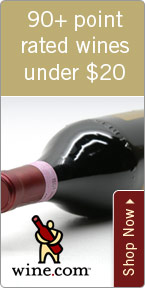Wines That Are Off The Chart

Wednesday - June 09, 2006
| Share
 Del.icio.us
Del.icio.usVintage charts are always an interesting topic of discussion and debate among oenophiles.
On one hand, a vintage chart is supposed to be a good helper for wine drinkers. It gives us general information on a certain year’s quality in a particular region.
On the other hand, vintage charts have many shortcomings and can even be quite misleading in some cases - which can have an insidious effect on the avid wine drinker.
One of the positives about a vintage chart is that it is supposed to help less-informed wine drinkers as well as collectors find the best years for wines that they may not necessarily know much about. It also gives a good barometer as to how the weather was in an area with the underlying assumption that the better the weather, the better the wines should have turned out.
But that doesn’t always hold true.
Just because a certain year was rated 99 points out of 100, does that mean that 99 percent of the wines that were produced in that year were great?
I know that not to be true. You probably know what I’m talking about: You bought a bottle of wine from a highly rated vintage only to taste something mediocre and lackluster. Conversely when a vintage is less regarded by wine writers, are all the wines supposed to be bad? What ever happened to the “cream always rises to the top”? I’ve had many experiences of drinking great wines that have come from vintages that were not supposed to be so good. Expectations certainly have something to do with it, but not entirely. The truth is that the greatest producers of wine produce great wines much more consistently than a vintage chart would suggest.
Another thing that puzzles me about vintage charts, especially when they rate vintages from New World areas like California, Australia, New Zealand and South Africa, is that I thought the greatness of the New World is its consistency of vintages. The technology of the New World certainly has helped to make the vintage variances quite minimal. Ever take a look at a vintage chart for Napa Valley? Apart from one year in 10, almost all the vintages are rated highly within two-three points of each other. Can you say “splitting hairs”?
Lastly, if you like mature and aged wines, just because a wine comes from a less than stellar vintage doesn’t mean it will not age well. Wines from “lesser” vintages often age quicker or reach their optimum drinking level long before those better vintages. In my book, that makes it even better in some cases. I don’t have to wait as long.
Vintage charts generalize, and that’s not a good thing to do with wine. Broad strokes just cannot explain the complexities of the wine world. The more and more I taste wines from all over the world the more I find that vintage differences only give me more diversity and more excitement to find the great wines, especially in “lesser” vintages.
I do think vintage charts can help direct some wine drinkers toward bettering their choices. But most people put too much weight on it and can miss out on some wonderful wines. Even some that are less expensive because the vintage was not so highly touted. Don’t miss out on great wines just because everybody else says the year was not!
Here are some great wines from so-called “bad” vintages:
1998 Scherrer Vineyards Cabernet Sauvignon $39. This is an elegant, delicious, really finesseful wine. It also has plenty of complexity that keeps you coming back for more.
2002 August Clape Cornas $69. This Syrah is splendid, deep, rich, tons of fruit and regal. I have this in my own cellar.
1998 Lisini Brunello di Montalcino $49. This Brunello is a standout. It has a beautiful floral character and elegance that is lacking in others from even the best vintages.
Roberto Viernes is a master sommelier. E-mail .(JavaScript must be enabled to view this email address)E-mail this story | Print this page | Comments (0) | Archive | RSS Comments (0) |
Most Recent Comment(s):












